| M20, Trifid Nebula - June 30, 2006 The conditions
at Cattle Point were very good, especially as I was shooting this image over
the water in a SE direction. I tried pushing my new Canon 30D dSLR to
ISO 3200 for this image, and it seems to have worked out quite well.
Joe Carr |
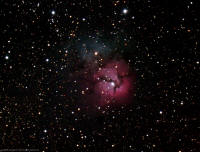 |
M11/NGC 6705 The Wild Duck Cluster - 29 June 2006
Taken : 29 June 2006 from Cattle Point
Charles Banville |
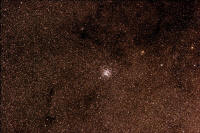 |
M17, Omega Nebula (also called the Swan) - June 28, 2006
Location: Cattle Point
John McDonald |
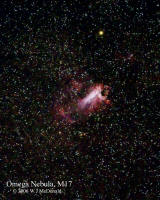 |
M16/NGC 6611 The Eagle Nebula - 27 June 2006
Taken from : Cattle PointCharles
Banville |
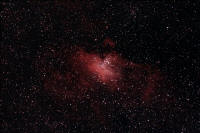 |
| M8, M20 & M21 - June 27, 2006 Charles, David and I
had very fine conditions for imaging at Cattle Point last night. No Moon, No
Wind, Good seeing and visibility. I got what I think is my best wide field
image yet. I could just get M8, M20 and M21 all in the field and I like
seeing these wonderful objects all together. It helps to get a sense of
their scale and separation.
John McDonald |
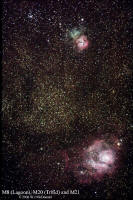 |
Gamma Cygni Region - 26 June 2006
Wide angle picture of Cygnus taken with Canon 50mm lens (covers
approximately 25 by 17 degrees). The bright star on the left is 37 Gamma
Cygni (Sadr). Notice the nebulosity in that region. 6 Beta Cygni (Albireo)
is located to the right of Sadr.
Charles Banville |
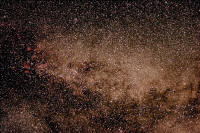 |
Sagittarius Star Cloud Region - 26 June 2006
John McDonald and I ended up going to Cattle Point on Sunday and Monday
nights. As you may have seen already, John took a wonderful shot of both M20
and M8. For my part, I decided to try out wide field astrophotography. This
is the first of two shots I captured using the Canon 50mm f/1.4 lens.
Unfortunately sky glow turned out to be problematic and part of the original
frame was taken out.
Some objects of interest in this picture: M16 The Eagle Nebula, M17 The
Lagoon Nebula, M18, M25, M24 The Sagittarius Stat Cloud a.k.a. Delle
Caustiche, M23, M21, M20 The Trifid Nebula, M22, M8 The Lagoon Nebula, M28
and a lot more...Charles
Banville |
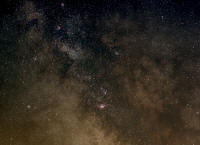 |
| M13 - June 25, 2006 Last night at Astronomy hill
was really great. After the Centre of the Universe closed (that sounds
ominous), Several of us stayed on to do some imaging. I focused my time on
M13 and got a result I am happy with. I have attached two versions. The
first is a blow up of the cluster and includes about 25% of the full frame
(by height). The second is a low resolution version of the full frame. I
have marked the location of M13 (pretty obvious) as well as NGC6207 (which
you may be able to see just to the left of the text). NGC 6207 is an 11.6
magnitude galaxy and is a fairly evident elongated smudge on the full
resolution version.
John McDonald |
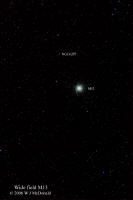
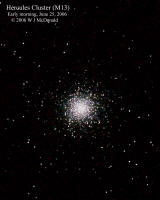 |
M51 - Whirlpool Galaxy - June 24, 2006
I acquired 30 images of M51 on Observatory Hill Saturday night using my
Canon 30D at prime focus on my LX-90. 14 of the images were of suitable
quality to stack. This is my first image of M51 in which some detail is
visible - it is an exceedingly dim object!
The "b" version
has the supernova highlighted.Joe
Carr |
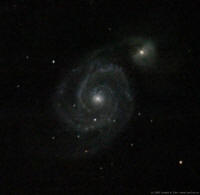 |
M8 The Lagoon Nebula & NGC 6523 - 24 June 2006
The globular star cluster in the bottom left corner of the frame is NGC
6544. Taken from Pearson College.
Charles Banville |
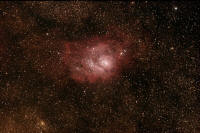 |
M17/NGC 6618 The Swan Nebula - June 24, 2006
Finally some clear skies. I went to Pearson College last night and was
rewarded with some good seeing conditions. Although Sagittarius is fairly
low in the sky from our location in Victoria, I managed to get some fair
results imaging the Swan Nebula.
Charles Banville |
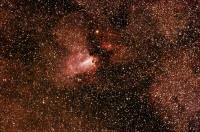 |
| NGC 5000 - North American Nebula - June 24, 2006
Details:
Location: Cattle Point
Telescope: WO 105mm with WO 0.8x flattener/reducer
Camera: Pentax ist-DS
Exposures 17 - 30 second shots at ISO 800
Processing in ImagesPlus, Photoshop and NeatImage
John McDonald |
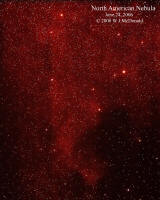 |
| M8 - Lagoon Nebula
- NGC6530 cluster - June 24, 2006 12:43am
Guy Walton, John McDonald and I setup at Cattle Point as
a last minute arrangement, however I think we are all glad we made the
effort. The sky was spongy in spots, but otherwise stable, yielding
some very good images. This is my second try at photographing the
Lagoon Nebula, and my first image of a deep space object using my new Canon
30D dSLR.
21 images used out of 30 taken, with Dark Frames
applied. Please refer to my
Deep Space personal
website for image details. Joe
Carr |
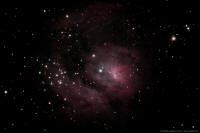 |
| M31 Andromeda Galaxy and M110 - June 23, 2006 I
processed 11, 30 sec. exposures at ISO 800 and 10 Darks with DeepSky Imager.
Adjusted stack with PhotoShop CS2 and Noise Ninja. If I can figure how to
use Images Plus, I am sure the results will be better. Camera was Nikon D50
on an Orion 100mm, F9 ED Refractor at prime focus.
Guy Walton |
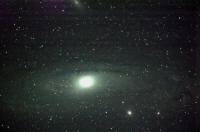 |
| Mars, M44 Saturn Conjunction - June 10-18, 2006 - I
managed a total of six observations of the wonderful merging of Mars, M44
and Saturn.
The panel of six sketches (inverted) chronicles the movement of Mars from
west of the Bee Hive Cluster (M44), through the cluster, then on to and past
Saturn. The linked circles are the twinning of the adjacent two-degree FOV
provided by a 40mm eyepiece in my f/8 6� dob. Start at the upper left and
move down, then go back up and read down on the right.
Follow the little
pale orange dot as it moves across the field. South is up. Saturn�s movement
away from M44 was apparent, but pales in comparison to the speed with which
Mars moved through the sky.
This was a really fun project to do. Bill
Weir
|
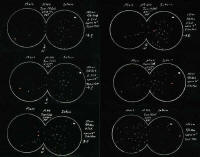 |
| Europa Shadow Transit of Jupiter - June 10, 2006
11:34pm-12:34am (11th) - Guy and I stayed to enjoy the clear skies after the public left
Observatory Hill on Saturday night. I took a series
of 24 resultant images using the Meade LPI webcam and Envisage software on a Meade
LX-90 f/10 SCT. The image to the right is the first in the sequence - the
clearest image. The shadow of Europa is clearly visible below the
equatorial band. Europa is transiting Jupiter within the same band on
the right side, however it is not visible The movie file consists of all
24 images in sequence, which shows the shadow transiting the planet, and
also illustrates how the "seeing" was quite variable.
Joe Carr |
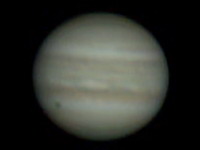
Time Lapse Movie
(29 seconds, 320x240, 293k WMV) Hint: Right Click on movie link and "Save
target as..." to download and play on your desktop. |
| Mars - M44 - Saturn - June 10, 2006 - Saturday night
I setup in the heart of Metchosin on the Cricket Pitch to get the best view
to the west that I could. Despite the nearly full Moon, bright western
horizon and the wind I was able to take in a magical sight. I capture this
view at around 2330hrs PDT, as viewed through my little 6" Dob at 30X with a
TFOV of 2 degrees. I linked together the adjacent fields for this sketch. I
then inverted it but retained the glistening red dot of Mars. Atmospheric
extintion and twilight obliterated all but one bright star close Mars. -
Bill Weir |
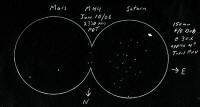 |
| M13 - May 18, 2006 - Looks like M13 was the target
of choice last Thursday. I used my NP-101 coupled to a 2x Powermate in my
attempt at capturing this globular cluster.Only 9 shots out of 40 made it
passed "quality control". Turns out that shooting at a focal length of over
1000mm is quite the challenge.
Charles Banville |
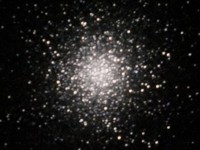 |
| Jupiter - May 18, 2006, 10:30pm This image was
taken from the lower parking lot on Observatory Hill. We experienced
quite stable viewing in the direction Jupiter was located over the city,
which was surprising. The amount of colour saturation in the equatorial
bands yields almost a chocolate brown colour.
Joe Carr |
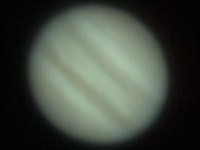 |
| Jupiter & moons - May 14, 2006 - Got some images of
Jupiter showing the red spot the evening of May 14. David, Joe and I went to
the hill and were rewarded with a very nice evening. The weather was
exceptionally good with warm wind free conditions and excellent seeing until
around midnight. I got several sequences of exposures of Jupiter all of
which were reasonably good. The attached represents the best one and my
personal best to date for this planet.
John McDonald |
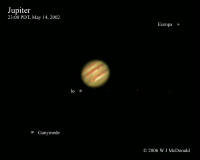 |
| Io Shadow Transit of Jupiter - May 13, 2006 After
the public left the Centre of the Universe, several Victoria Centre members
remained to enjoy the clear and fairly stable observing conditions. Since
there was a full Moon, I decided to stick with planetary viewing. My
target was Jupiter. This is my first time lapse video of a planet in
motion, and it shows the shadow transit of Io, one of Jupiter's moons.
Joe Carr |
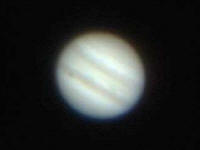
Time
Lapse Movie (15 seconds, 320x240, 284k WMV)
Hint: Right Click on movie link and "Save target as..." to download and play
on your desktop. |
| M13 Hercules Cluster - May 13, 2006 - I finally
figured what I was doing wrong with freeware program DeepSkyStacker and now
the images are registering correctly. Here are some results. M13 was taken
last night at the DAO. The bright moon probably reduced the overall quality
but for me, this is my third night out to do imaging and I am happy with the
results. Guy Walton |
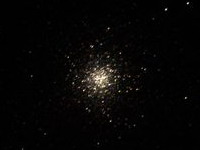 |
| The Moon - May 13, 2006 I have been wishing the
moon wasn't so bright on some of the clear nights as I am anxious to try
some deep sky imaging. However, it is was there and I decided I might as
well enjoy it. My image shows some nice detail of the nearly full moon.
John McDonald |
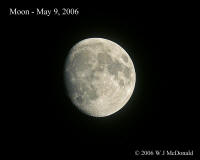 |
| The Moon - May 13, 2006 - I finally had an
opportunity where the weather and desire coincided with some astro-imaging.
After accumulating some equipment over the winter I had a chance to try out
the DSI Pro and the MiniBorg 45ED.
David Lee |
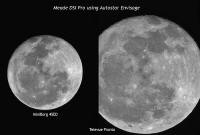 |
| Jupiter's Red Spot - May 9, 2006 I had a go at
imaging Jupiter's Great Red Spot and was pleased that I could capture it
with the camera as well as visually. The attached shows the result.
John McDonald |
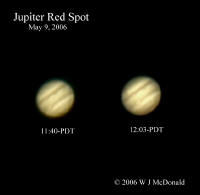 |
| Moon - May 7, 2006 Here is an image of the Moon
taken with A Nikon D50 at ISO 800 on my Orion 100mm, f9 ED refractor.
Guy Walton |
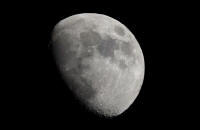 |
| M57 Ring Nebula and Comet 73/P Schwassmann-Wachmann -
May 7, 2006 - I tried my new DSLR for the first time on M57 with
the hopes of capturing the comet.. et Voila... a modest success.
Telescope.... Orion 80 ED F/7 , one single 1 minute exposure at ISO 800.
tracking on EQ5 mount with minimal alignment. Now to learn about
processing,,, my next challenge.
Bruno Quenneville |
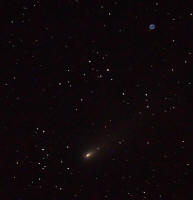 |
| M81 - May 2, 2006 - After seeing a demonstration of
Neat Image from Joe a few weeks ago I proceeded in acquiring the
aforementioned program. Here's my shot of M81 taken from Cattle Point
on May 2, 2006 processed with Neat Image.
Charles Banville |
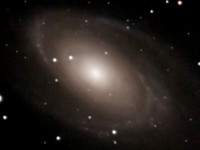 |
| Comet 73/P Schwassmann-Wachmann - May 2, 2006 -
Image taken at Cattle Point using my Orion 100 f/9 ED refractor on EQ4 mount
with a Nikon D50 at 30 seconds with NR on. I stacked 3 images using a
freeware program called Deep Sky Stacker.
Guy Walton |
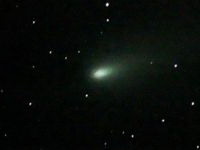 |
| Comet 73/P Schwassman-Wachmann - May 2, 2006 - Taken
at Cattle Point when the comet was in Hercules. 68 Herculis is in the field
of view of the photo below the comet. Schwassman-Wachmann C 73/P has a very
distinct tadpole shape. I don't see two nuclei either visually or in this
image. Joe Carr |
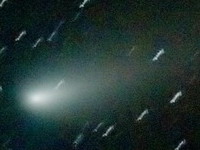 |
| M51 Whirlpool Galaxy & M104 Sombrero Galaxy - Apr 21,
2006 - both using a Meade 10" LX-6 SCT at f/3.3 and an SBIG 2000XM CCD
imager, 30 second exposure processed with Maxim DL.
Photos by Mona Aditya, Tomas Jagelka & Mark Wheen,
Pearson College |

 |
| Comet 73P/Schwassmann-Wachmann - April 22, 2006 - A few
of us met at Pearson College last night. I had a great time although
transparency wasn't the best. I took shots of the Leo Triplet and comet Schwassmann-Wachmann.
Comet 73P:
Telescope: Tele Vue NP-101
Camera: Canon 20Da
Vixen GP-DX equatorial mount, tracking but no guiding
Exposures: 3X60 sec @ISO 800 Processed with Images Plus. Triplet:
Telescope: Tele Vue NP-101
Camera: Canon 20Da
Vixen GP-DX equatorial mount, tracking but no guiding
Exposures: 11X60 sec @ISO 800 Processed with Images Plus.
Charles Banville |
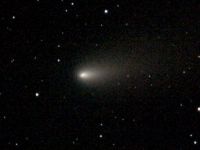
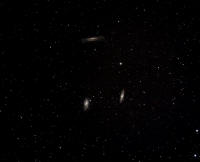 |
| 73P/Schwassmann-Wachmann - April 14, 2006 Over the
past week I've had a chance to observe this interesting periodic comet a
total of three times. It returns approximately every 5yrs. In 1995 it
fractured into three components that now travel around together. They are
separated from each other by a couple of degrees.
At present the two
brightest parts (B & C) are quite easily visible telescopically as they
travel through Bootes heading towards Hercules. If you want to read more
about them all sorts of information including a very accurate
finder
chart is available here.
Even with the bright Moon on the 5th I was able to find them both quite
easily with my 6" dob. The night before I'd observed them with my 12.5" dob
but was just faintly able to spot them with it's 12X80 mm finder. I'd
estimate them both to be between 9th and 10th magnitude. The attached sketch
I did using my 12.5" dob at 317X. Their movement in the sky was quite
apparent over the period of time I observed them. That star at the tip of
the coma in the top sketch was close to the pseudo nucleus 1.5 hrs earlier.
I hope others get the chance to observe them or even better yet get a nice
wide-field shot. I've seen one and they both show up quite well.
Bill Weir |
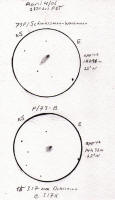 |
| Total Solar Eclipse from south of Tobruk,
Libya - Mar 29, 2006 Sequences approaching both Diamond rings and
one at totality; also first contact, which I was pleased to record with the
slightest indication. The sunspots show up quite well on the western limb.
See Michael Web's Online Gallery
for more photos in the series. |
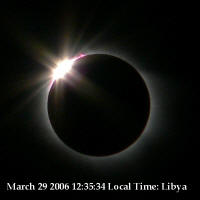 |
Total Solar Eclipse from the Libyan Sahara Desert -
March 29, 2006
As we counted down to First Contact, people were really getting excited.
Finally, "first contact" was shouted out, and we all looked up to see the
first chunk of the Sun being eclipsed by the Moon. What a strange site! Over
the next few minutes more and more of the Sun was eclipsed, until we could
feel the temperature of the Saharan heat start to drop. Next came a strange
change in the colour of the surrounding light. As things started to darken
more, the temperature also dropped more - a total of 7 or 8�C by the end.
At Second Contact, the Moon totally eclipsed the Sun, and the Diamond Ring
(see my image above) appeared for a brief few seconds, closely followed by Baily's Beads and solar flares. What a site, and it happens so quickly! Then
for 4 minutes we have the total eclipse to enjoy and photograph. The Sun's
corona was magnificent, flowing outward from the Sun in huge streamers. I was
taking photographs all through the sequence, and will have several more to
share on my website once I return home. The full eclipse phase is so
strange, since no solar filters are needed to observe the Sun while
fully-eclipsed by the Moon.
Too soon we came to Third Contact, where we have to again use solar filters,
since the energy of the Sun is now at full strength. Some of our group
observed until Fourth Contact, making observations along the way. Being less
dedicated, I stopped photographing during this phase, and just enjoyed the
occasional glance at the eclipsed sun through my binoculars.
Joe Carr |
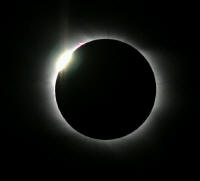 |
Partial Eclipse from Santorini, Greece - March 29, 2006
Here is a set containing a few of the images I took of the partial
eclipse of the sun on April 29 from Fira, Santorini, Greece. I tried to get
to the island of Kastellorizo where there would be totality but it was
difficult to do so I settled for a partial. The first shot was from the
previous day when the weather was great. However on the 29th, the weather
was variable cloudy and windy making it difficult to get a consistent set.
If you look closely you can make out sunspots on the 2nd, third and fourth
images. John McDonald |
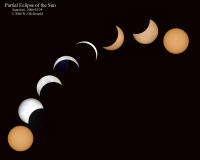 |
M42 - Orion Nebula -
Feb 10, 2006
Joe Carr invited us to Observers Hill for what turned out to be a clear
night with some good views. There was a nearly full moon but the clear air
was a treat after a long period of muck. I spent the whole evening
collecting photons of the Orion Nebula region with my wide angle setup.
These two images represent a combination of the material I got on Friday
evening with previous shots from October 11, 2005.
John McDonald |
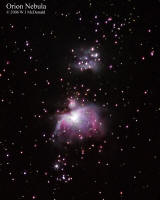 |
| Saturn - Feb 2, 2006 - - using a C8 at f/20 and an SBIG
ST 2000xm CCD imager, 100 images stacked using Maxim DL. Photo by Sebastian
Arroyo at Pearson College. |
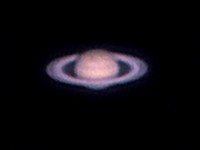 |
| Saturn & Beehive Cluster - Jan 31, 2006 - Did anyone else manage to take
advantage of the short break in the monsoons? I went to Pearson tonight for
the class but no one showed. When the wind started to blow the clouds away I
was the winner. I dragged out the school's 10" dob and put my 40mm widefield
eyepiece in it. The almost 2 degree FOV it gave just fit the bill. Jan 31st
is the day that Saturn is closest to M44. It's only 0.9� from its centre.
Here is a sketch of what I saw. It was a view, that I think I will remember
forever.
Bill Weir |
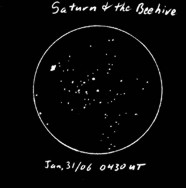 |